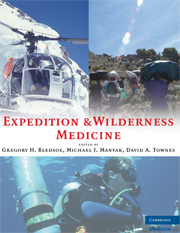Book contents
- Frontmatter
- Contents
- Contributors
- Foreword
- Preface
- Acknowledgments
- PART I EXPEDITION PLANNING
- PART II EXPEDITIONS IN UNIQUE ENVIRONMENTS
- 13 Tactical and Protective Medicine
- 14 Hostile Geopolitical Environments
- 15 Aerospace Medicine
- 16 Polar Medicine
- 17 Tropical Medicine for Expeditions
- 18 Subterranean Medicine
- 19 High-Altitude Medicine
- 20 Medicine at Sea
- 21 Event Medicine
- 22 Telemedicine in Evolution: Implications for Expeditionary Medicine
- 23 Dive Medicine
- PART III ILLNESS AND INJURIES ON EXPEDITIONS
- APPENDIX The Expedition Medical Kit
- Index
20 - Medicine at Sea
from PART II - EXPEDITIONS IN UNIQUE ENVIRONMENTS
Published online by Cambridge University Press: 05 March 2013
- Frontmatter
- Contents
- Contributors
- Foreword
- Preface
- Acknowledgments
- PART I EXPEDITION PLANNING
- PART II EXPEDITIONS IN UNIQUE ENVIRONMENTS
- 13 Tactical and Protective Medicine
- 14 Hostile Geopolitical Environments
- 15 Aerospace Medicine
- 16 Polar Medicine
- 17 Tropical Medicine for Expeditions
- 18 Subterranean Medicine
- 19 High-Altitude Medicine
- 20 Medicine at Sea
- 21 Event Medicine
- 22 Telemedicine in Evolution: Implications for Expeditionary Medicine
- 23 Dive Medicine
- PART III ILLNESS AND INJURIES ON EXPEDITIONS
- APPENDIX The Expedition Medical Kit
- Index
Summary
INTRODUCTION
Explorations at sea differ from those on land. A ship at sea is a self-contained community that must provide all the services needed by those aboard, including medical care. Though most expeditions actually require relatively few medical services, proper planning is necessary to ensure that the appropriate services, including emergency care, are available when needed. In addition to actual medical treatment, public health and preventive services are also essential to a safe and rewarding venture. The early planning stages of the expedition should be used to begin to identify the needed resources. The specifics will vary with the characteristics of the expedition. The success of the expedition in fulfilling its mission is often dependent upon adequately addressing these health issues prior to leaving shore.
The first section addresses the variables that determine the health care needs underway, and how those needs can be met. The next section discusses several medical conditions that are relatively common on seagoing expeditions. The last section addresses safety, public health, and personal health behaviors. Proper predeployment planning and careful attention to health concerns underway are key to a successful seagoing expedition.
PREDICTING AND ADDRESSING HEALTH CARE NEEDS AFLOAT
As the expedition leader begins the early planning process, questions are asked such as: What pharmaceuticals should we bring? and What vaccinations do we need? Unfortunately these questions don't have standard answers applicable to every expedition.
- Type
- Chapter
- Information
- Expedition and Wilderness Medicine , pp. 264 - 293Publisher: Cambridge University PressPrint publication year: 2008



